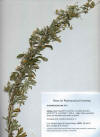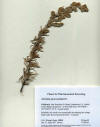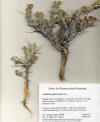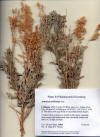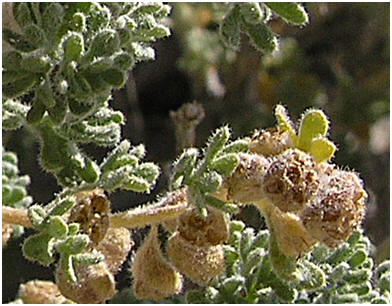|
Artemisia arbuscula California—Tehachapi Mts., Fort Tejon State Park, East of Winters Ridge. CNPS Field Trip, Apr 17, 2016. Showing Little sagebrush scrub alliance and close-up of plants.
|
Artemisia arbuscula Utah—Great Basin Desert-Bonneville Basin. Beaver Co., BLM: Pine Valley along the western flanks of the Wah Wah Mts., ~15 mi south of Hwy 21, Escalante Desert region; 38º12'00.4", 13º39.52.5", 1899 m. Low sagebrush scrub. Low, rigid, shrub, densely branched, rounded and hemispherical, 20–30 cm high and broad. A dominant plant in heavily grazed scrub. Samples of root-rhizome (rt-rh) and twig-leaf (tw-lf). Richard Spjut & Paul Burchstead 16354, June 21. 2008.
|
|
|
Artemisia californica California. Ventura Co.: Pine Mt., June 2012
|
Artemisia cana California. Warner Mts., Modoc Co. Corporation Meadow. 41º09.621, 120º12.645. Aspen sagebrush meadows with high density of Veratrum californicum, and with Wyethia mollis, Aug 20, 2009. |
|
|
Artemisia douglasiana California. Lassen NF: Open forest near Susan River, on east side of A21; 40º29.652, 121º04.422, 5300 ft. Jeffrey pine, lodgepole pine, woodland with willow thickets and scattered clumps of Veratrum californicum, 21 Aug 2009.
|
Artemisia douglasiana Along South Fork of the Salmon River, Klamath NF, CA; August 2006 |
Artemisia furcata Alaska, Hwy 2 at Delta
Junction
|
|
Artemisia nova Escalante Desert, UT,
dominant shrub;
|
Artemisia pycnocephala Coastal scrub, Mendocino
Co., CA |
Artemisia pycnocephala Coastal scrub, Monterrey
Co., CA |
|
Artemisia spinescens |
Artemisia spinescens |
Artemisia spinescens |
|
Artemisia sp. Kern Co., CA. E Sierra
Nevada, |
Artemisia tridentata ssp. tridentata Kern Co., CA. Piute Mts. Region, between Piute Mt. and Caliente. Bioblitz, May 9, 2015. |
Artemisia tridentata
ssp. tridentata |
|
Artemisia tridentata
with sponge gall midge
|
Artemisia tridentata
ssp. parishii |
Artemisia tridentata
ssp. parishii
|
|
Artemisia tridentata
ssp. parishii |
Artemisia tridentata
ssp. vaseyana |
|
|
Trees and Shrubs of Kern County (Sep 2012, Jun 2016) . Aromatic annuals to shrubs, or rarely tree-like; leaves alternate, simple or lobed or divided into leaflets; flower heads generally small and not showy, with <30 pale yellow disc flowers <4mm in length, usually many in a linear array along terminal elongate flowering stems, the flower axis branched or simple; marginal flowers in some species unisexual but tubular (raylike in A. bigelovii); inner disc flowers fertile, or only male developed; involucral bracts in 1–4 (-7) imbricate graduated series, often with a green midrib and scarious margins; fruit a small achene usually <3 mm long, without a pappus, or crown-like pappus present in A. rothrockii, A. californica and A. papposa. 350+ spp., largely northern hemisphere, also South America and Africa; 50 in the U.S., 19 (native) in California, 6 in Kern Co; 18 reportedly used medicinally by American Indians (Moerman). Artemisia annua Linnaeus (wormwood) contains artemisinin, a sesquiterpene lactone,that has become an important drug for treating malaria in tropical regions; it is an annual native to East Asia that has become naturalized in Europe, eastern US and elsewhere. Among 212 extracts of Artemisia screened by the NCI for antitumor activity prior to 1980, two were active from samples collected of A. cana (P-388 Leukemia) from Alberta, Canada and of A. frigida (KB) collected on Pinal Mt., Arizona. Active agents were likely sesquiterpene lactones that were considered to hold little promise for cancer chemotherapy (Hartwell 1976). Seven species in Kern County; four are shrubs; the other three are perennials with a bushy habit as a result of numerous erect stems produced from horizontally spreading rhizomes; A. dracunculus Linnaeus 1753.distingiushed by long narrow leaves, ± machete-shaped to sickle- shaped, occasionally with shorter divisions or three-lobed; A. douglasiana Besser 1833 with broader variously lobed or incised leaves and A. ludoviciana Nuttall 1818 that differs from the preceding by the plants covered with a mat of white tangled hairs. Key to Species of Artemisia 1. Branches ending in spines; low shrubs................................... Artemisia spinescens 1. Not spiny................................................................................................................ 2
2. Stem leaves
uniformly narrow, not lobed or divided; generally
2.
Stems leaves deeply
divided into narrow lobes from mid region, or
3.
Stem-leaves uniformly
narrow, often divided into 3-linear
3. Stem leaves
widening from base to apex (wedge-shaped), and terminally
4. Flower-fruit stems (inflorescence) > than their woody leafy stems
4. Flower-fruit stems < woody stems, with many relatively short to
fewer longer
5. Flower heads >3 mm diam with 8–20 flowers; leaves sticky, 1–2.5 cm;
5. Flower heads 1–3 mm diam with 3–6 flowers; leaves not
......
6. Broad ± flat-topped shrubs, leafy stems <1.5 m high; leaves
...... 6. Hemispherical shrubs; leafy stems >1 m high; leaves
...... 7. Flowering stems 15–30 cm long; flower heads (involucres) ±
twice
...... 7. Flowering stems 5–15 cm long; flower heads ± as long as wide,
Artemisia arbuscula Nuttall 1841 ssp. arbuscula. Dwarf sagebrush, little sagebrush. Described by Cronquist (Intermountain Flora 5, 1994) as “similar to A. tridentata, and with the characteristic spicy odor of A. tridentata vars. tridentata and wyomingensis, but smaller, mostly 1–3 dm tall exclusive of the inflorescences, not sprouting after fire; leaves relatively small, up to 1.5 or seldom 2 cm long, sometimes more deeply toothed than in A. tridentata, but the teeth or segments, even when relatively elongate, more than 6 times as long as wide, and the undivided portion of the blade evidently widened distally; inflorescence congested and more or less spiciform; seldom more than 1.5 cm wide; involucre narrow, 3–5 mm high, at least the middle and outer bracts gray-tomentose; flowers 4–8 per head.” Slopes and ridges, sagebrush scrub, juniper woodland between (3,000-) 4,000 and 12,000 ft; Rocky Mts. west to Washington and California. Type from arid plains of Upper California, Lewis River. Little sagebrush scrub (alliance) recognized in MCV2 when > 30% relative cover in the shrub canopy. Not reported in Twisselmann, Moe (2016), or the CCH in Kern Co. The CCH records from Tulare Co include the Dome Land Wilderness at Black Mt, and from the South Fork of the Kern River at Templeton Meadow. Twisselmann et al. collected it at Monache Meadow along east side at the base of Deer Island, and at Cirque Peak. Its reported occurrence here from Kern County was from my observations and photos during a Kern Chapter CNPS field trip, April 2016, to the Fort Tejon State Park where east of Winters Ridge. ~2000 m elev., above the pass, white fir forest below on northern slope. Typical variety has entire leaves among the flowering stems whereas that of var. longiloba has 3-lobed leaves. Artemisia californica Lessing 1831. California sagebrush. Aromatic, sparingly branched shrub to 2 m from shallow roots, stems usually white hairy over brownish fibrous bark, weakly ascending to erect, twigs striate; leaves green except for appressed gray hairs, deciduous in summer, rarely simple, occasionally in fascicles, usually once divided from mid to upper third into narrow linear segments of uniform width and length, strongly inrolled, not more than 1 mm wide, occasionally unequally divided more than once, 1–10 cm long; flowers Aug–Nov; flower heads on terminal parts of leafy stems, individually nodding on short curved stalks (peduncles) in leaf or bract axils, 3–5 mm wide, rays 6–10 with pale yellow stigmas; disk florets reddish maroon, 15–30; achenes rectangular-box-like but narrowed at one end (“oblong turbinate”). Open slopes and flats in scrub, Coast Ranges below 3,000 ft from Sonoma County to Baja California (San Antonio, Islas Cedros and Guadalupe). Type from California. California sagebrush scrub (Alliance) recognized in MCV2 when >60% relative cover in shrub canopy, or co-dominant alliances recognized with California buckwheat (Eriogonum fasciculatum) or black sage (Salvia mellifera) when 30–60% relative cover in shrub canopy. Kern Co.: “Common in the woody Upper Sonoran associations in the Temblor and San Emigdio ranges” (Twisselmann), 240–762 m. Artemisia cana Pursh 1814. Hoary sagebrush, silver sagebrush. Rhizomatous shrub, sprouting after fire, 0.4–1 (-2) m, sometimes sticky and losing hair late in the season; leaves narrow, usually entire or some apically 3-toothed; flowering Aug–Sep; flower stems 15–30 cm long, leafy, the lower inflorescence leaves similar to those of vegetative stems, reduced upwards; flower heads crowded with (5-) 8–15 per head; involucres 3–5 mm high.. Southern Saskatchewan to Colorado, Nebraska, west to the Cascades of Oregon, California, eastern Sierra Nevada where recognized as belonging to ssp. bolanderi (A. Gray) G. H. Ward. Cronquist (Intermountain Flora, 1994) felt that only the plants from Mono Co. deserve further distinction, and only as a variety. Indicated in MCV2 to occur in Kern Co., but not supported by other literature or specimens. Aside from one questionable from Tulare Co. Kern River (C. Purpus 1 Aug 1896), the southernmost Calfornia occurrences are Heart Lake - Rock Creek Lake Basin at 10,600 ft and in the vicinity of Olancha near Owens Lake, Inyo Co.(CCH). Artemisia rothrockii A. Gray 1876. Timberline sagebrush, Rothrock’s sagebrush. Shrub generally < 1 m high, flowering Aug–Sep; differs from A. tridentata in having sticky leaves, less branched flower stems and larger flower heads with more flowers per head. Often forming a fringe around middle and high elevation meadows, 2,350–3,650 m; generally from Lake Tahoe region south in the Sierra Nevada to Tulare Co., Sweetwater Mts. White Mts., and San Bernardino Mts. Collections from north of Mammoth Lakes and Tioga Pass referred to A. rothrockii have been also considered to be A. spiciformis by Cronquist (Intermountain Flora 5, 1994). Type from Monache Meadows, Sierra Nevada, Tulare Co. (visited by Cronquist). Indicated in MCV2 to occur in Kern Co., but no specimens or other literature found to support this. Collected by Twisselmann in Tulare Co, north end of Big Meadow - Sierra Nevada, Kern Plateau, 29 Aug 1967.
Artemisia spinescens D. C. Eaton 1871 [Picrothamnus
desertorum Nuttall 1841]. Bud sage. Low aromatic shrub with
a well-developed woody trunk with thick furrowed bark, to 50 cm high,
the main stem divided into few rigid branches bearing numerous wide
spreading spine-tipped twigs, The species, morphologically distinct from other species of Artemisia, also referred to its own genus, Picrothamnus, however, morphological and molecular studies indicate that it should be retained in Artemisia (Vallès et al. 2003). Artemisia tridentata Nuttall 1841. Big Sagebrush. Medium to large shrub, 1–6 m high; leaves aromatic, inverted triangular in outline (wedge-shaped), usually shallowly three lobed near apex, silvery hairy, remaining on the twigs for more than one season. Flowers Aug–Oct, usually 3–6 (or more) in a head subtended by 8–15 involucral imbricate bracts; the outermost shorter and round-oval, the inner more elliptical and longer; the flower heads closely aligned along simple leafy floral stems; achen ribbed or striated, hairy or glandular. Common shrub of the high desert or rain shadow slopes in the western US, at elevations as low as 1,500 ft. Type from the Plains of the Oregon, and Lewis River. Big sagebrush scrub recognized in MCV2 when ≥2% absolute cover in the shrub canopy not exceeded by other associated shrub species. Four subspecies in California, three in Kern Co., 605–2,438 m. Typical (ssp. tridentata) has erect flower branches (inflorescences) with flower heads (involucres) about equally as long as wide; ssp. parishii (A. Gray) H.M. Hall & Clements 1923, which sometimes has weeping flower branches, is easily identified by the subcylindric involucres, and ssp. vaseyana (Rydberg) Beetle 1959 is recognized by its flattened crown as opposed to hemispherical in the other subspecies. Subspecies wyomingensis Beetle & A. M. Young 1965, which is not known from Kern County, differs in having shorter flowers stems (“paniculiform arrays”), 2–8 cm, partly below leafy branches as opposed to 5–30 cm in the other subspecies.
References on Pharmacological Activity in Artemisia Abdelgaleil S. A., M. A. Abbassy, A. S. Belal and M. A. Abdel Rasoul. 2007. Bioactivity of two major constituents isolated from the essential oil of Artemisia judaica L. Bioresour. Technol. Dec. “The essential oil of Artemisia judaica L., grown on Sinai Peninsula of Egypt, was extracted via hydrodistillation. Chromatographic separation on repeated silica gel columns led to isolate two compounds namely piperitone and trans-ethyl cinnamate. Insecticidal, antifeedant and antifungal properties of the isolated compounds were examined. Both compounds showed pronounced insecticidal and antifeedant activity against the third instar larvae of Spodoptera littoralis (Boisd). trans-Ethyl cinnamate (LD(50)=0.37mug/larva) was more toxic than piperitone (LD(50)=0.68mug/larva). The two isolated compounds revealed antifeedant activity in a concentration dependent manner, with complete feeding inhibition at a concentration of 1000mug/ml. When tested for antifungal activity against four plant pathogenic fungi, the isolated compounds exhibited a moderate to high activity.” Lee S. H., M. Y. Lee, H. M. Kang, D. C. Han, K. H. Son, D. C. Yang, N. D. Sung, C. W. Lee, H. M. Kim and B. M. Kwon. 2003. Anti-tumor activity of the farnesyl-protein transferase inhibitors arteminolides, isolated from Artemisa. Bioorg. Med. Chem. 11(21): 4545–4549. “Members of the Artemisia genus are important medicinal plants found throughout the world. Arteminolides A-D (1-4), isolated from the aerial parts of Artemisia, have an inhibitory activity on farnesyl-protein transferase (FPTase; EC 2.5.1.29) in in vitro assay. This study was carried out with the purpose of validating anti-tumor effects of the compounds in human tumor cells and mouse xenograft model. The arteminolides inhibited tumor cell growth in a dose-dependent manner. Furthermore, arteminolide C (3) blocked in vivo growth of human colon and lung tumor xenograft without the loss of body weight in nude mice.” Mu D., W. Zhang, D. Chu, T. Liu, Y. Xie, E. Fu and F. Jin. 2007. The role of calcium, P38 MAPK in dihydroartemisinin-induced apoptosis of lung cancer PC-14 cells. Cancer Chemother. Pharmacol. Jul. “Dihydroartemisinin (DHA), a semi-synthetic derivative of artemisinin isolated from the traditional Chinese herb Artemisia annua, is an effective novel antimalarial drug. Recent studies suggest that it also has anticancer effect. PURPOSE: The present study was designed to investigate the effects of DHA on cultured human lung cancer cells (PC-14 cells) to better understand its apoptosis and apoptosis-related factors in vitro. METHODS: The cell viability was measured by MTT assay. The apoptosis induction was examined by DNA ladder and flow cytometry. The intracellular-free calcium concentration in the lung cancer cells were evaluated by laser scanning confocal microscopy with Fura-3/AM as probe. The associated gene expression was examined by Western blot. RESULTS: After treatment with DHA, a decrease in the viability of PC-14 cells and apoptosis were observed. DHA-induced apoptosis were accompanied by an increase of Ca(2+) and activation of p38. Deleted levels of Ca(2+) by BAPTA-AM 20 muM or inhibition of p38 by its selective inhibitor SB202190 then led to decreased DHA-induced apoptosis. CONCLUSIONS: These results demonstrated that DHA can induce apoptosis of lung cancer cell line PC-14 cells and calcium and p38 play important roles in the apoptotic signalling pathways.” Wang J., Y. Guo, B. C. Zhang, Z. T. Chen and J. F. Gao. 2007. Induction of apoptosis and inhibition of cell migration and tube-like formation by dihydroartemisinin in murine lymphatic endothelial cells. Pharmacology 80(4): 207–218. “Dihydroartemisinin (DHA) is a semisynthesized agent from the artemisinin first extracted from the Chinese plant Artemisia annua. Previous studies have shown that artemisinin derivates, apart from their antimalarial activity, possess antitumor, antiangiogenic, and anti-inflammatory effects. In the present investigation, DHA was found to have a potent ability in influencing lymphatic endothelial cells (LECs) behavior. Murine LECs were isolated from benign lymphangiomas induced by intraperitoneal injection of incomplete Freund's adjuvant and identified by indirect immunofluorescence assay and fluorescence-activated cell sorting analysis to examine the expression of the specific marker VEGFR-3/Flt-4. When LECs were treated with DHA at 10 microg/ml, the growth of LECs was inhibited, and LECs showed typical apoptotic morphological features, with a higher apoptotic rate as compared with the controls. DHA also exerted a significant inhibitory effect on migration and tube-like formation of LECs in a dose-dependent manner. Quantitative RT-PCR further showed that DHA remarkably downregulated the expression of antiapoptotic bcl-2 mRNA, but upregulated that of the proapoptotic gene bax mRNA. In addition, DHA could strongly attenuate the mRNA and protein levels of VEGFR-3/Flt-4. In summary, these findings indicate that DHA may be useful as a potential lymphangiogenesis inhibitor under induction of cell apoptosis, inhibition of the migration, and formation of tube-like structures in LECs.” Wendel G. H., A. O. María, J. A. Guzmán, O. Giordano, L. E. Pelzer. 2008. Antidiarrheal activity of dehydroleucodine isolated from Artemisia douglasiana. Fitoterapia. 79(1):1-5. “Dehydroleucodine (DhL), a sesquiterpene lactone obtained from Artemisia douglasiana, was screened for antidiarrheal effects. DhL inhibited castor oil-induced diarrhea in mice by judged by a decrease in the number of wet faeces in the DhL-treatment groups. DhL significantly reduced intestinal transit in mice. Yohimbine and phentolamine counteracted the inhibitory effect of DhL. It is suggested that alpha(2)-adrenergic receptors mediate the effect of DhL in intestinal motility. DhL reduced also intraluminal accumulation of fluid. Thus, the antidiarrheal activity of DhL is possibly related, at least in part, to its inhibitory action against gastrointestinal motility and the inhibition of enteropooling property.” Zhou H. J., W. Q. Wang, G. D. Wu, J. Lee and A. Li. 2007. Artesunate inhibits angiogenesis and downregulates vascular endothelial growth factor expression in chronic myeloid leukemia K562 cells. Vascul. Pharmacol. 47(2-3): 131–138. “Artesunate (ART), a semi-synthetic derivative of artemisinin extracted from the Chinese herb Artemisia annua, is a safe and effective antimalarial drug. In the present investigation, we analyzed the inhibitory effects of ART on angiogenesis and on VEGF production in chronic myeloid leukemia (CML) K562 cells in vitro and in vivo. In order to analyze the effect of ART on VEGF secretion in K562 cells, we examined the level of VEGF secreted in conditioned media (CM) by ELISA assay. The result showed that ART could decrease the VEGF level in CM of K562 cells, even at a lower concentration (2 micromol/l, P<0.01). The inhibitory effect of in vitro angiogenesis was tested on aortic sprouting in fibrin gel. ART could effectively suppress the stimulating angiogenic ability of CM by pretreated with K562 cells for 48 h in a time-dependent manner (days 3-14). The antiangiogenic effect of ART was further evaluated in vivo in chicken chorioallantoic membrane (CAM) neovascularization model. The result indicated that the stimulating angiogenic activity was decreased in response to the K562 cells treated with ART or the CM from K562 cells pretreated with ART in a dose-dependent manner (3-12 micromol/l). Furthermore, we analyzed the level of VEGF expression by western blot and detected the form of VEGF mRNA by RT-PCR in K562 cells. The experiments showed that ART could inhibit the VEGF expression, correlated well with the level of VEGF secreted in CM. These findings suggest that ART might present potential antileukemia effect as a treatment for CML therapy, or as an adjunct to standard chemotherapeutic regimens.”
|
||








